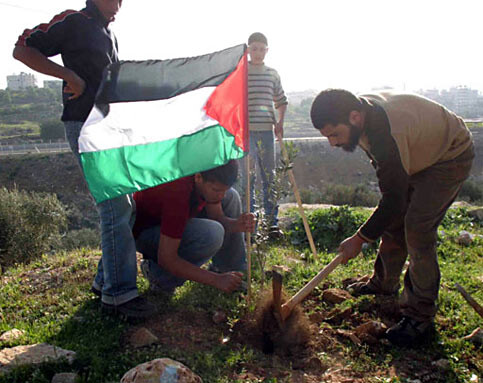The Electronic Intifada 23 October 2005

Villagers in Beit Hanina plant olive trees as a form of resistance. (Photo: Stop the Wall Campaign)
The fact that thousands of Palestinians and hundreds of Israelis are together employing nonviolent tactics similar to those of the U.S. civil rights movement and the South African anti-Apartheid movement would come as surprising and welcome news to most Americans. Americans are largely unaware of the struggling but vibrant grassroots nonviolent movement in Palestine, because the U.S. corporate media prefers a simple, flawed story of Palestinian terrorist attacks and Israeli retaliation.
In the U.S. media, Palestinians generally aren’t allowed to speak for themselves or to articulate their historical narrative. Israelis, however, are permitted to speak, to explain the Israeli experience and even to explain about Palestinians. As a result, the Israeli story is known in the U.S. while Palestinians are dehumanized.
The reporting by The New York Times, often cited as the standard for U.S. media, typifies the problem. The Times publishes daily news articles on Israel/Palestine, including countless articles about armed Palestinian resistance. However, the New York Times and the U.S. media more generally almost never report on what 99.5% of Palestinians have done every day of their lives for the last 38 years — nonviolently resist Israeli occupation.
Over the last three years the New York Times has published only three feature articles on Palestinian nonviolent resistance. This despite the fact that Palestinians have conducted hundreds of nonviolent protests over the last three years throughout the West Bank against Israel’s construction of the Wall on Palestinian land, and despite the fact that the Israeli army killed nine Palestinian protesters, wounded several thousand protesters, harassed and collectively punished villages that protested, and arrested hundreds of protesters, including nonviolent protest leaders.
The most recent of those three Times articles, on October 16th, “At Israeli Barrier, More Sound than Fury” by the Times’ Jerusalem Bureau Chief Steven Erlanger is a good case study of how Israel/Palestine is typically misrepresented by the U.S. media, and how Palestinian nonviolence is marginalized. Only six words in the 1,138 word article are quotes from Palestinians, though the article centers on a Palestinian-led protest against Israel’s construction of a Wall cutting through the West Bank village of Bil’in.
Erlanger seems to instead let Israeli protesters speak for the Palestinians. Nonetheless, he still quotes twice as many words from Israeli soldiers in Bil’in as from the Israeli protesters. Consequently, as is too often the case in U.S. media, the explanations of the Israeli military dominate. A seemingly good-natured and oft-quoted Israeli general is the only individual who readers can get a feel for. Palestinians from Bil’in simply serve as scenery, and are never heard.
Perhaps because they generally don’t allow Palestinians to speak, the Times and the U.S. media generally leave out the broader context. In this article, Erlanger omits 80 protests in Bil’in, three years of nonviolent resistance to the Wall in the West Bank, the rich Palestinian history of nonviolent resistance, and the Israeli military’s brutal repression of nonviolent dissent.
Instead Erlanger mentions only that there are weekly protests in Bil’in, and that “There were some injuries and numerous arrests, and one soldier lost an eye from a rock.” “Baton-wielding soldiers and police officers, whose use of stun grenades, rubber bullets and tear gas made it look as if Israel was repressing dissent.”
If allowed to speak, Palestinians would have cited evidence showing that Israel clearly is violently repressing peaceful dissent in Bil’in and many other villages. Tens of protesters from Bil’in have been arrested, including protest organizer Abdullah Abu Rahme. Abu Rahme was arrested three times for a total of 35 days, and has now been banned by an Israeli court from attending protests.

Palestinians protesting Land Week in April 2005. (Photo: Stop the Wall Campaign)
361 protesters have been injured over seven months in Bil’in. One young Palestinian man almost died after being shot in the head with a rubber-coated steel bullet. Three Palestinians and an Israeli were seriously wounded when hit by teargas canisters fired from guns at close range. However, the only specific injury that is noted in the article is one to the Israeli soldier who lost his eye, the single most serious injury to a soldier during three years of protests against the Wall.
The Times article does mention that Israel’s construction of the Wall and settlements inside the West Bank in places like Bil’in violate international law according to the International Court of Justice and the United Nations. However, Israeli government responses to those international positions are given equal space and weight.
With the U.S. corporate media’s tendency to silence Palestinians, it is no wonder that many Americans see Palestinians as the aggressor in the conflict, even though they live under Israeli military occupation. Alternative and non-U.S. media are currently the only resources for Americans to learn about the Palestinian narrative and grassroots nonviolent resistance in Palestine
Still, just relying on alternative media is not enough. The public needs to keep the pressure on the corporate media and newspapers like the New York Times through letters and critical articles, until they accurately represent both sides of the story in Israel/Palestine.
Patrick O’Connor is an activist with the International Solidarity Movement (ISM). ISM is conducting an 15 October-15 November 11-city U.S. speaking tour featuring two prominent organizers of nonviolent resistance to Israeli occupation, Palestinian Ayed Morrar and Israeli Jonathan Pollak. For details on the tour see www.palsolidarity.org. This article was first published on ZNet on October 17, 2005.





